Developing Self-Awareness for Effective Leadership
VerifiedAdded on 2023/01/18
|11
|3067
|1
AI Summary
This article explores the importance of self-awareness in leadership development and provides strategies for enhancing self-awareness. It also discusses various leadership theories and their application in motivating and inspiring others in the workplace. The article emphasizes the role of effective communication and recognition in employee motivation.
Contribute Materials
Your contribution can guide someone’s learning journey. Share your
documents today.
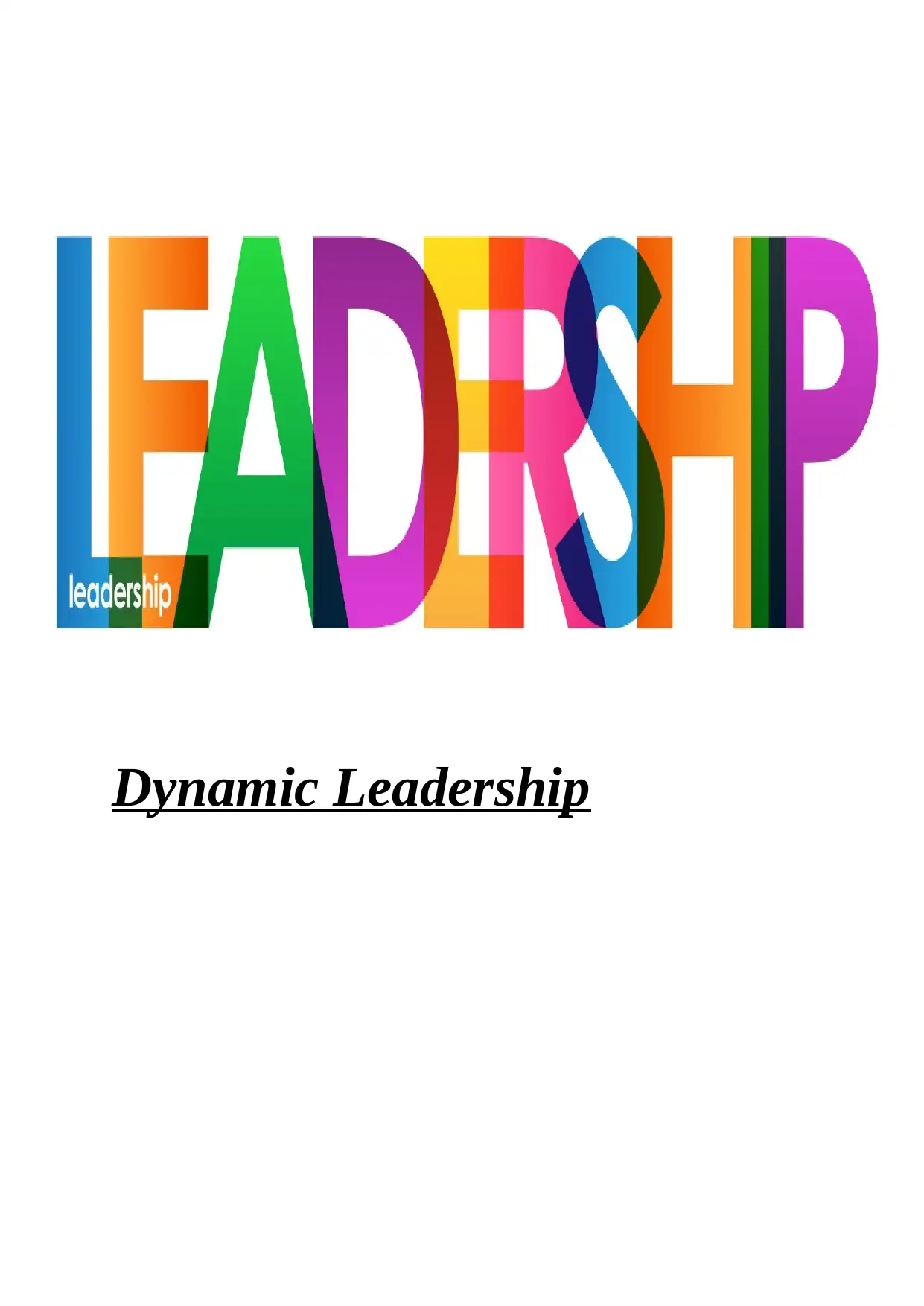
Dynamic Leadership
Secure Best Marks with AI Grader
Need help grading? Try our AI Grader for instant feedback on your assignments.
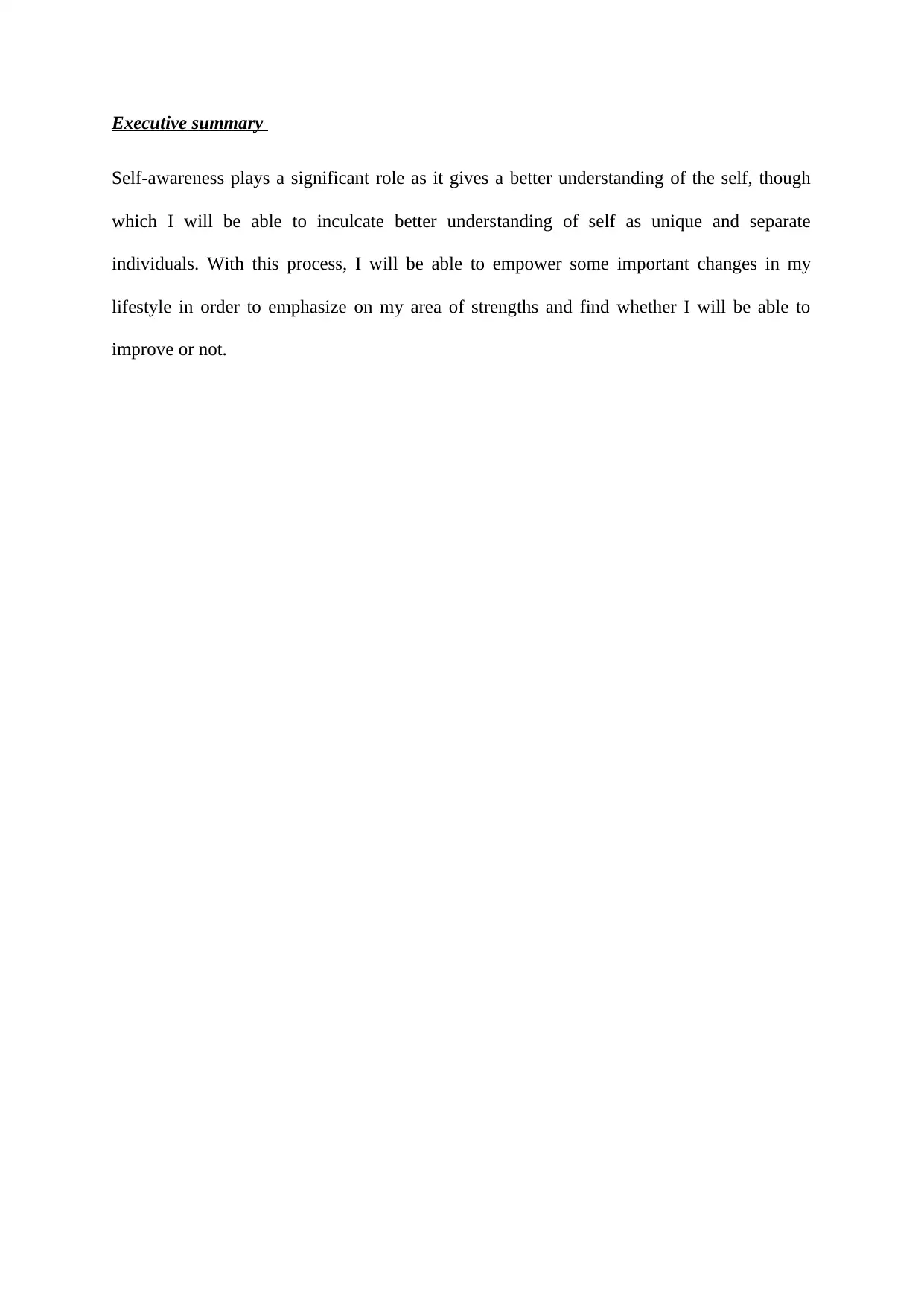
Executive summary
Self-awareness plays a significant role as it gives a better understanding of the self, though
which I will be able to inculcate better understanding of self as unique and separate
individuals. With this process, I will be able to empower some important changes in my
lifestyle in order to emphasize on my area of strengths and find whether I will be able to
improve or not.
Self-awareness plays a significant role as it gives a better understanding of the self, though
which I will be able to inculcate better understanding of self as unique and separate
individuals. With this process, I will be able to empower some important changes in my
lifestyle in order to emphasize on my area of strengths and find whether I will be able to
improve or not.
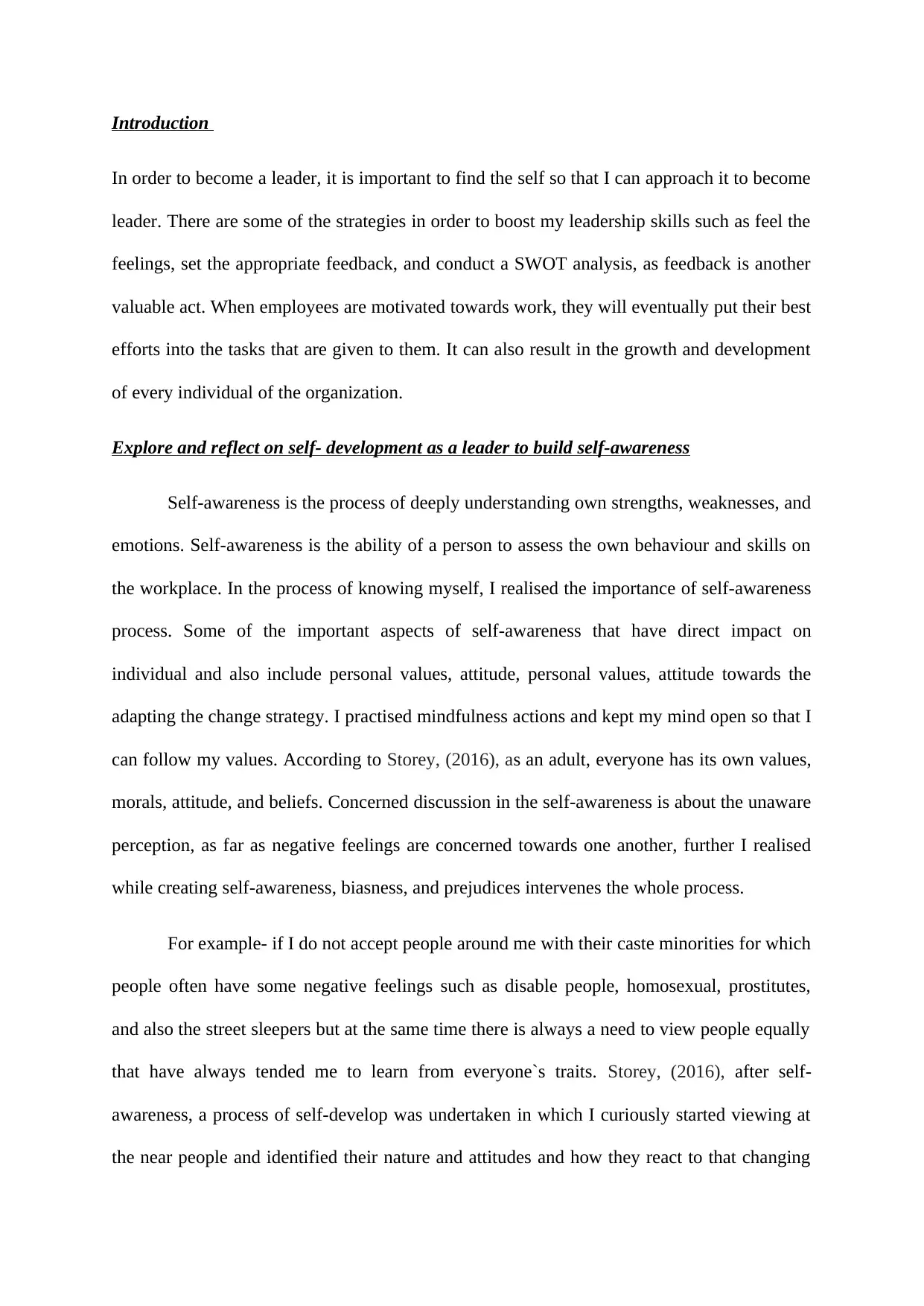
Introduction
In order to become a leader, it is important to find the self so that I can approach it to become
leader. There are some of the strategies in order to boost my leadership skills such as feel the
feelings, set the appropriate feedback, and conduct a SWOT analysis, as feedback is another
valuable act. When employees are motivated towards work, they will eventually put their best
efforts into the tasks that are given to them. It can also result in the growth and development
of every individual of the organization.
Explore and reflect on self- development as a leader to build self-awareness
Self-awareness is the process of deeply understanding own strengths, weaknesses, and
emotions. Self-awareness is the ability of a person to assess the own behaviour and skills on
the workplace. In the process of knowing myself, I realised the importance of self-awareness
process. Some of the important aspects of self-awareness that have direct impact on
individual and also include personal values, attitude, personal values, attitude towards the
adapting the change strategy. I practised mindfulness actions and kept my mind open so that I
can follow my values. According to Storey, (2016), as an adult, everyone has its own values,
morals, attitude, and beliefs. Concerned discussion in the self-awareness is about the unaware
perception, as far as negative feelings are concerned towards one another, further I realised
while creating self-awareness, biasness, and prejudices intervenes the whole process.
For example- if I do not accept people around me with their caste minorities for which
people often have some negative feelings such as disable people, homosexual, prostitutes,
and also the street sleepers but at the same time there is always a need to view people equally
that have always tended me to learn from everyone`s traits. Storey, (2016), after self-
awareness, a process of self-develop was undertaken in which I curiously started viewing at
the near people and identified their nature and attitudes and how they react to that changing
In order to become a leader, it is important to find the self so that I can approach it to become
leader. There are some of the strategies in order to boost my leadership skills such as feel the
feelings, set the appropriate feedback, and conduct a SWOT analysis, as feedback is another
valuable act. When employees are motivated towards work, they will eventually put their best
efforts into the tasks that are given to them. It can also result in the growth and development
of every individual of the organization.
Explore and reflect on self- development as a leader to build self-awareness
Self-awareness is the process of deeply understanding own strengths, weaknesses, and
emotions. Self-awareness is the ability of a person to assess the own behaviour and skills on
the workplace. In the process of knowing myself, I realised the importance of self-awareness
process. Some of the important aspects of self-awareness that have direct impact on
individual and also include personal values, attitude, personal values, attitude towards the
adapting the change strategy. I practised mindfulness actions and kept my mind open so that I
can follow my values. According to Storey, (2016), as an adult, everyone has its own values,
morals, attitude, and beliefs. Concerned discussion in the self-awareness is about the unaware
perception, as far as negative feelings are concerned towards one another, further I realised
while creating self-awareness, biasness, and prejudices intervenes the whole process.
For example- if I do not accept people around me with their caste minorities for which
people often have some negative feelings such as disable people, homosexual, prostitutes,
and also the street sleepers but at the same time there is always a need to view people equally
that have always tended me to learn from everyone`s traits. Storey, (2016), after self-
awareness, a process of self-develop was undertaken in which I curiously started viewing at
the near people and identified their nature and attitudes and how they react to that changing
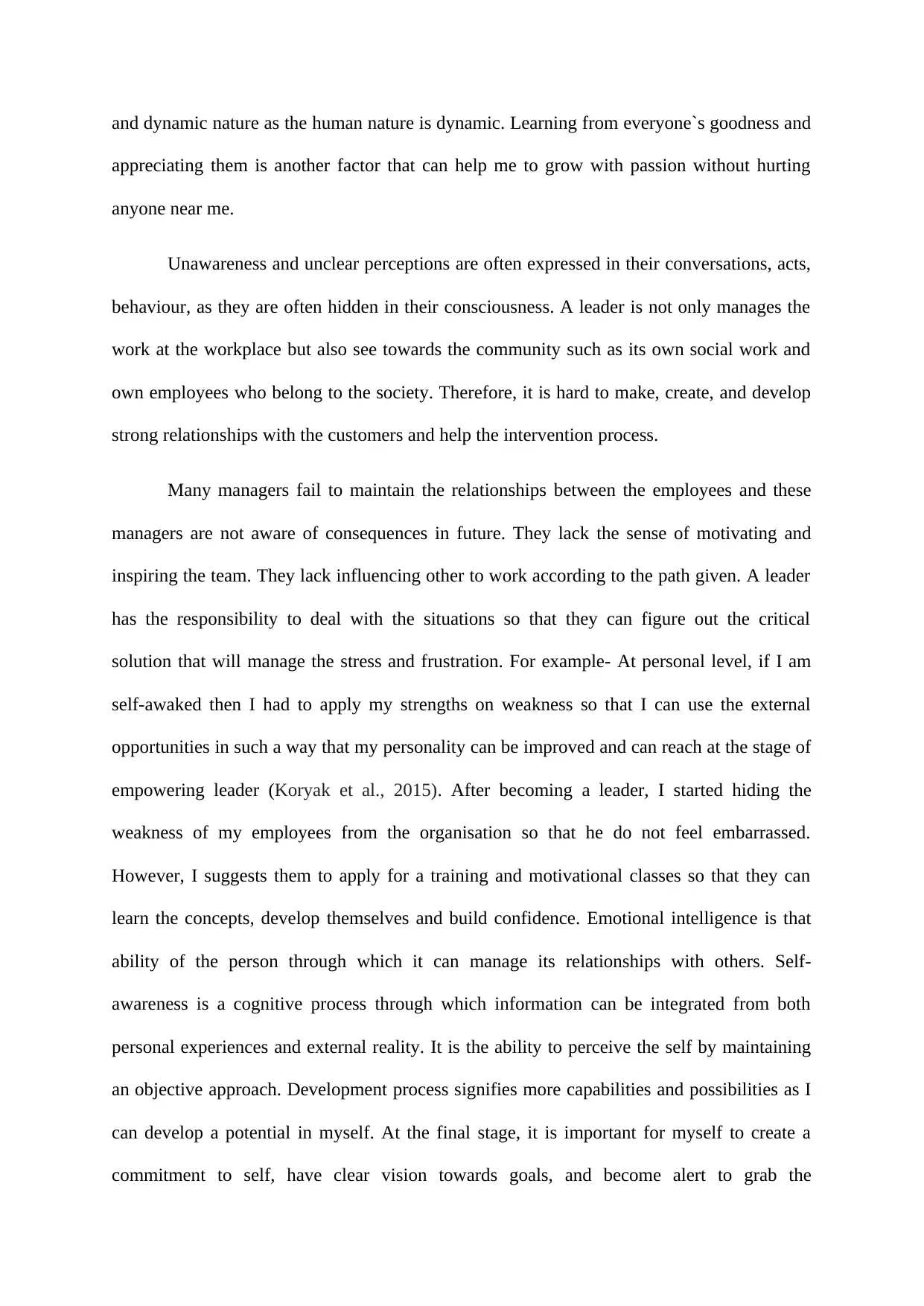
and dynamic nature as the human nature is dynamic. Learning from everyone`s goodness and
appreciating them is another factor that can help me to grow with passion without hurting
anyone near me.
Unawareness and unclear perceptions are often expressed in their conversations, acts,
behaviour, as they are often hidden in their consciousness. A leader is not only manages the
work at the workplace but also see towards the community such as its own social work and
own employees who belong to the society. Therefore, it is hard to make, create, and develop
strong relationships with the customers and help the intervention process.
Many managers fail to maintain the relationships between the employees and these
managers are not aware of consequences in future. They lack the sense of motivating and
inspiring the team. They lack influencing other to work according to the path given. A leader
has the responsibility to deal with the situations so that they can figure out the critical
solution that will manage the stress and frustration. For example- At personal level, if I am
self-awaked then I had to apply my strengths on weakness so that I can use the external
opportunities in such a way that my personality can be improved and can reach at the stage of
empowering leader (Koryak et al., 2015). After becoming a leader, I started hiding the
weakness of my employees from the organisation so that he do not feel embarrassed.
However, I suggests them to apply for a training and motivational classes so that they can
learn the concepts, develop themselves and build confidence. Emotional intelligence is that
ability of the person through which it can manage its relationships with others. Self-
awareness is a cognitive process through which information can be integrated from both
personal experiences and external reality. It is the ability to perceive the self by maintaining
an objective approach. Development process signifies more capabilities and possibilities as I
can develop a potential in myself. At the final stage, it is important for myself to create a
commitment to self, have clear vision towards goals, and become alert to grab the
appreciating them is another factor that can help me to grow with passion without hurting
anyone near me.
Unawareness and unclear perceptions are often expressed in their conversations, acts,
behaviour, as they are often hidden in their consciousness. A leader is not only manages the
work at the workplace but also see towards the community such as its own social work and
own employees who belong to the society. Therefore, it is hard to make, create, and develop
strong relationships with the customers and help the intervention process.
Many managers fail to maintain the relationships between the employees and these
managers are not aware of consequences in future. They lack the sense of motivating and
inspiring the team. They lack influencing other to work according to the path given. A leader
has the responsibility to deal with the situations so that they can figure out the critical
solution that will manage the stress and frustration. For example- At personal level, if I am
self-awaked then I had to apply my strengths on weakness so that I can use the external
opportunities in such a way that my personality can be improved and can reach at the stage of
empowering leader (Koryak et al., 2015). After becoming a leader, I started hiding the
weakness of my employees from the organisation so that he do not feel embarrassed.
However, I suggests them to apply for a training and motivational classes so that they can
learn the concepts, develop themselves and build confidence. Emotional intelligence is that
ability of the person through which it can manage its relationships with others. Self-
awareness is a cognitive process through which information can be integrated from both
personal experiences and external reality. It is the ability to perceive the self by maintaining
an objective approach. Development process signifies more capabilities and possibilities as I
can develop a potential in myself. At the final stage, it is important for myself to create a
commitment to self, have clear vision towards goals, and become alert to grab the
Secure Best Marks with AI Grader
Need help grading? Try our AI Grader for instant feedback on your assignments.
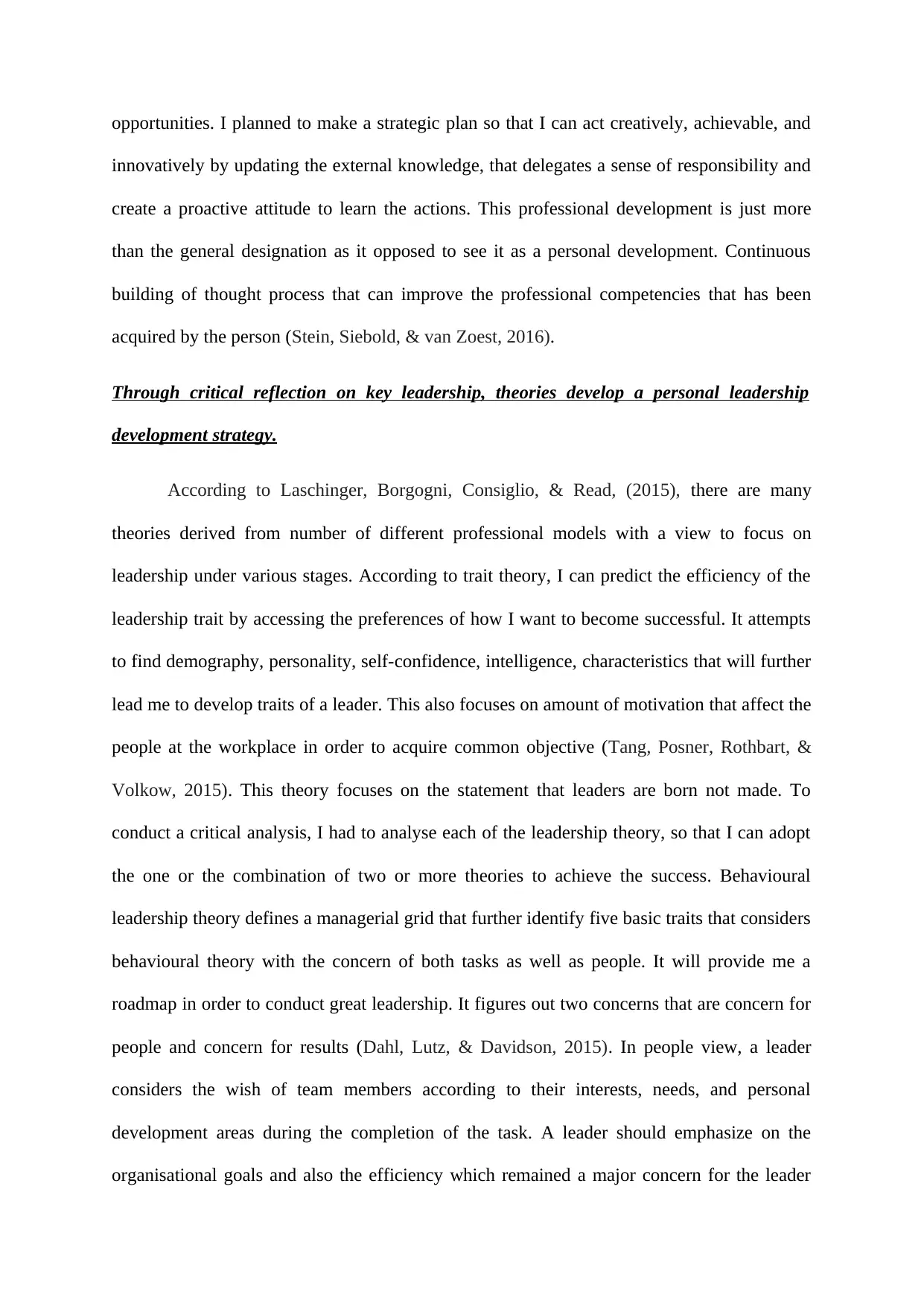
opportunities. I planned to make a strategic plan so that I can act creatively, achievable, and
innovatively by updating the external knowledge, that delegates a sense of responsibility and
create a proactive attitude to learn the actions. This professional development is just more
than the general designation as it opposed to see it as a personal development. Continuous
building of thought process that can improve the professional competencies that has been
acquired by the person (Stein, Siebold, & van Zoest, 2016).
Through critical reflection on key leadership, theories develop a personal leadership
development strategy.
According to Laschinger, Borgogni, Consiglio, & Read, (2015), there are many
theories derived from number of different professional models with a view to focus on
leadership under various stages. According to trait theory, I can predict the efficiency of the
leadership trait by accessing the preferences of how I want to become successful. It attempts
to find demography, personality, self-confidence, intelligence, characteristics that will further
lead me to develop traits of a leader. This also focuses on amount of motivation that affect the
people at the workplace in order to acquire common objective (Tang, Posner, Rothbart, &
Volkow, 2015). This theory focuses on the statement that leaders are born not made. To
conduct a critical analysis, I had to analyse each of the leadership theory, so that I can adopt
the one or the combination of two or more theories to achieve the success. Behavioural
leadership theory defines a managerial grid that further identify five basic traits that considers
behavioural theory with the concern of both tasks as well as people. It will provide me a
roadmap in order to conduct great leadership. It figures out two concerns that are concern for
people and concern for results (Dahl, Lutz, & Davidson, 2015). In people view, a leader
considers the wish of team members according to their interests, needs, and personal
development areas during the completion of the task. A leader should emphasize on the
organisational goals and also the efficiency which remained a major concern for the leader
innovatively by updating the external knowledge, that delegates a sense of responsibility and
create a proactive attitude to learn the actions. This professional development is just more
than the general designation as it opposed to see it as a personal development. Continuous
building of thought process that can improve the professional competencies that has been
acquired by the person (Stein, Siebold, & van Zoest, 2016).
Through critical reflection on key leadership, theories develop a personal leadership
development strategy.
According to Laschinger, Borgogni, Consiglio, & Read, (2015), there are many
theories derived from number of different professional models with a view to focus on
leadership under various stages. According to trait theory, I can predict the efficiency of the
leadership trait by accessing the preferences of how I want to become successful. It attempts
to find demography, personality, self-confidence, intelligence, characteristics that will further
lead me to develop traits of a leader. This also focuses on amount of motivation that affect the
people at the workplace in order to acquire common objective (Tang, Posner, Rothbart, &
Volkow, 2015). This theory focuses on the statement that leaders are born not made. To
conduct a critical analysis, I had to analyse each of the leadership theory, so that I can adopt
the one or the combination of two or more theories to achieve the success. Behavioural
leadership theory defines a managerial grid that further identify five basic traits that considers
behavioural theory with the concern of both tasks as well as people. It will provide me a
roadmap in order to conduct great leadership. It figures out two concerns that are concern for
people and concern for results (Dahl, Lutz, & Davidson, 2015). In people view, a leader
considers the wish of team members according to their interests, needs, and personal
development areas during the completion of the task. A leader should emphasize on the
organisational goals and also the efficiency which remained a major concern for the leader
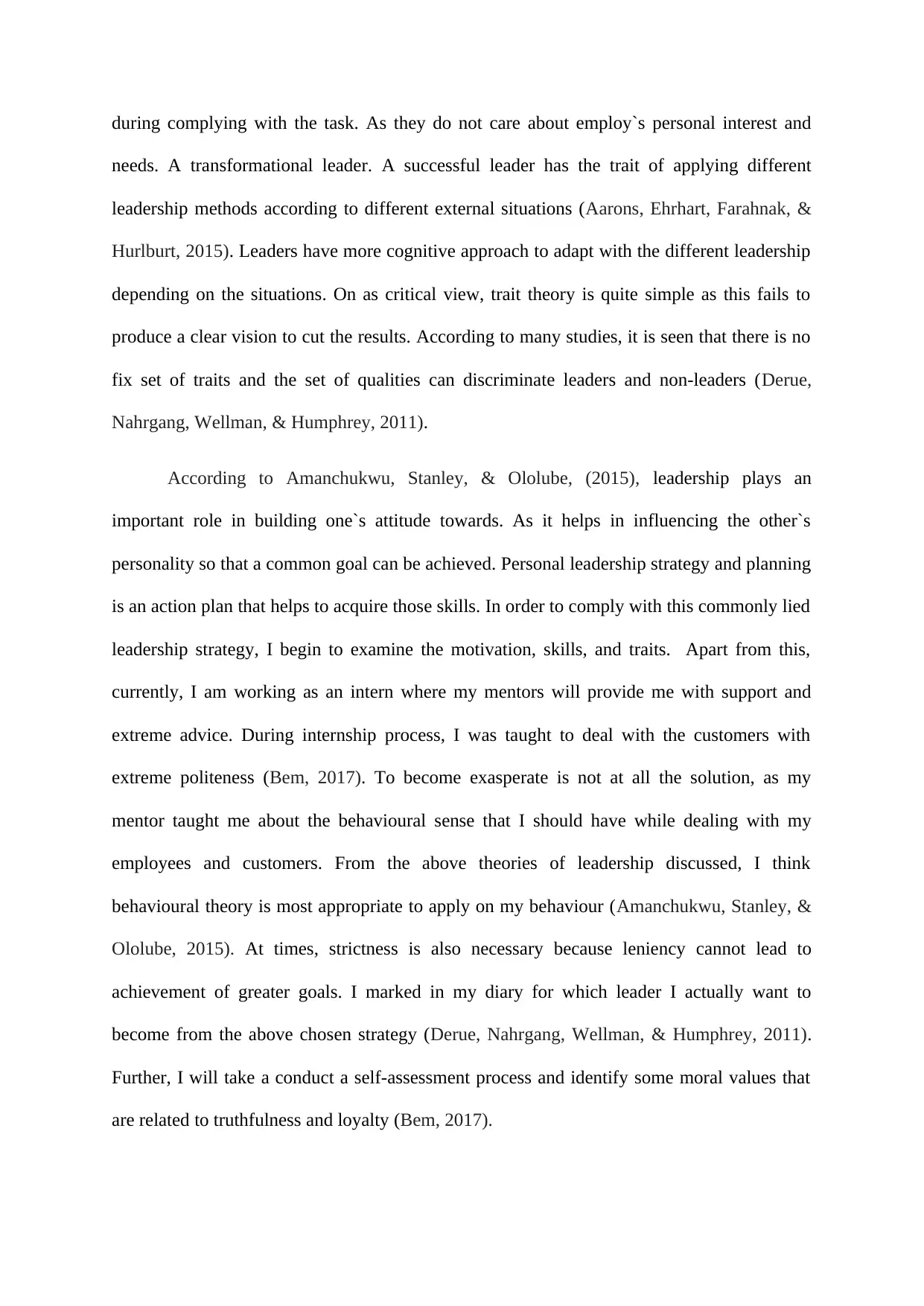
during complying with the task. As they do not care about employ`s personal interest and
needs. A transformational leader. A successful leader has the trait of applying different
leadership methods according to different external situations (Aarons, Ehrhart, Farahnak, &
Hurlburt, 2015). Leaders have more cognitive approach to adapt with the different leadership
depending on the situations. On as critical view, trait theory is quite simple as this fails to
produce a clear vision to cut the results. According to many studies, it is seen that there is no
fix set of traits and the set of qualities can discriminate leaders and non-leaders (Derue,
Nahrgang, Wellman, & Humphrey, 2011).
According to Amanchukwu, Stanley, & Ololube, (2015), leadership plays an
important role in building one`s attitude towards. As it helps in influencing the other`s
personality so that a common goal can be achieved. Personal leadership strategy and planning
is an action plan that helps to acquire those skills. In order to comply with this commonly lied
leadership strategy, I begin to examine the motivation, skills, and traits. Apart from this,
currently, I am working as an intern where my mentors will provide me with support and
extreme advice. During internship process, I was taught to deal with the customers with
extreme politeness (Bem, 2017). To become exasperate is not at all the solution, as my
mentor taught me about the behavioural sense that I should have while dealing with my
employees and customers. From the above theories of leadership discussed, I think
behavioural theory is most appropriate to apply on my behaviour (Amanchukwu, Stanley, &
Ololube, 2015). At times, strictness is also necessary because leniency cannot lead to
achievement of greater goals. I marked in my diary for which leader I actually want to
become from the above chosen strategy (Derue, Nahrgang, Wellman, & Humphrey, 2011).
Further, I will take a conduct a self-assessment process and identify some moral values that
are related to truthfulness and loyalty (Bem, 2017).
needs. A transformational leader. A successful leader has the trait of applying different
leadership methods according to different external situations (Aarons, Ehrhart, Farahnak, &
Hurlburt, 2015). Leaders have more cognitive approach to adapt with the different leadership
depending on the situations. On as critical view, trait theory is quite simple as this fails to
produce a clear vision to cut the results. According to many studies, it is seen that there is no
fix set of traits and the set of qualities can discriminate leaders and non-leaders (Derue,
Nahrgang, Wellman, & Humphrey, 2011).
According to Amanchukwu, Stanley, & Ololube, (2015), leadership plays an
important role in building one`s attitude towards. As it helps in influencing the other`s
personality so that a common goal can be achieved. Personal leadership strategy and planning
is an action plan that helps to acquire those skills. In order to comply with this commonly lied
leadership strategy, I begin to examine the motivation, skills, and traits. Apart from this,
currently, I am working as an intern where my mentors will provide me with support and
extreme advice. During internship process, I was taught to deal with the customers with
extreme politeness (Bem, 2017). To become exasperate is not at all the solution, as my
mentor taught me about the behavioural sense that I should have while dealing with my
employees and customers. From the above theories of leadership discussed, I think
behavioural theory is most appropriate to apply on my behaviour (Amanchukwu, Stanley, &
Ololube, 2015). At times, strictness is also necessary because leniency cannot lead to
achievement of greater goals. I marked in my diary for which leader I actually want to
become from the above chosen strategy (Derue, Nahrgang, Wellman, & Humphrey, 2011).
Further, I will take a conduct a self-assessment process and identify some moral values that
are related to truthfulness and loyalty (Bem, 2017).
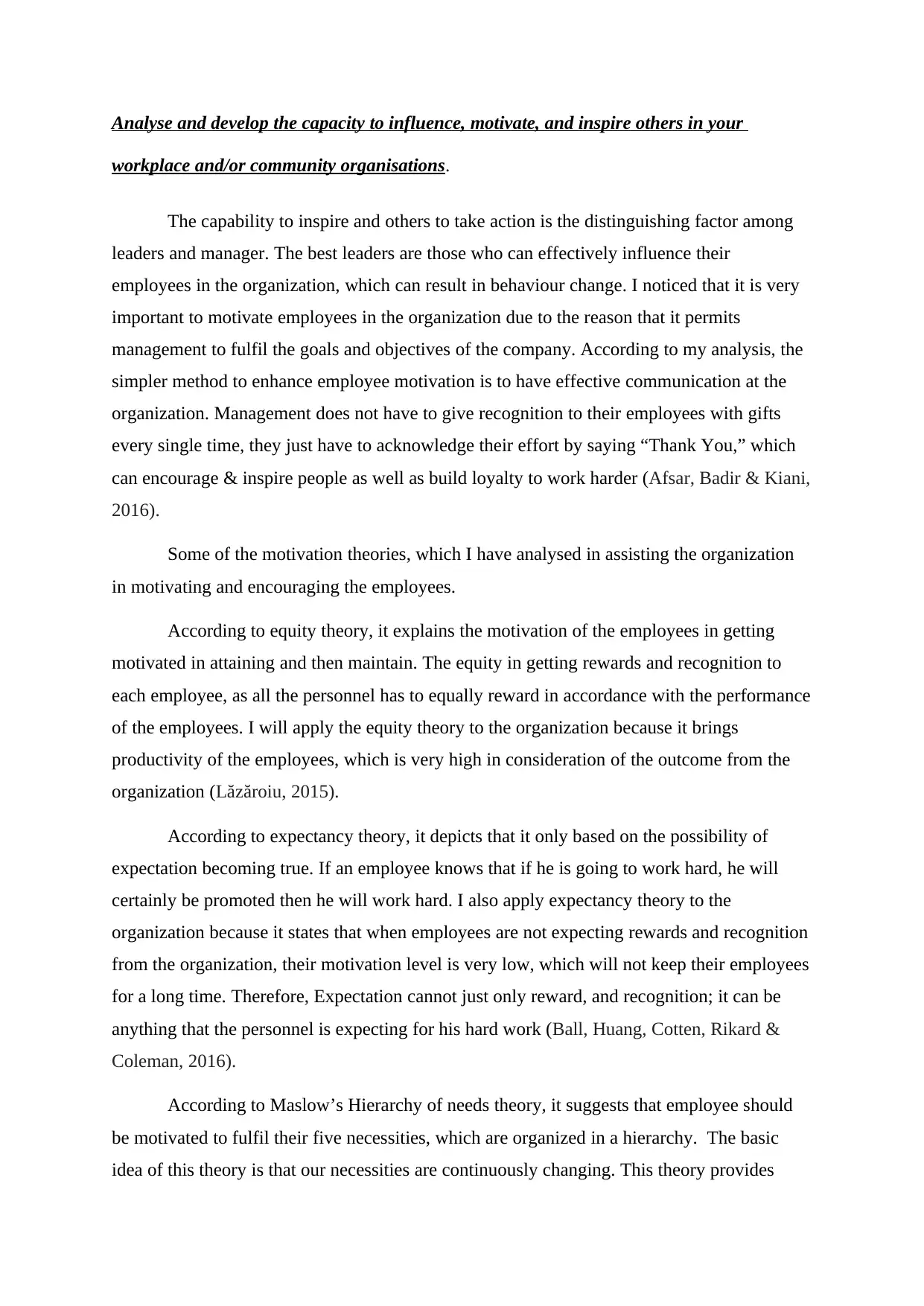
Analyse and develop the capacity to influence, motivate, and inspire others in your
workplace and/or community organisations.
The capability to inspire and others to take action is the distinguishing factor among
leaders and manager. The best leaders are those who can effectively influence their
employees in the organization, which can result in behaviour change. I noticed that it is very
important to motivate employees in the organization due to the reason that it permits
management to fulfil the goals and objectives of the company. According to my analysis, the
simpler method to enhance employee motivation is to have effective communication at the
organization. Management does not have to give recognition to their employees with gifts
every single time, they just have to acknowledge their effort by saying “Thank You,” which
can encourage & inspire people as well as build loyalty to work harder (Afsar, Badir & Kiani,
2016).
Some of the motivation theories, which I have analysed in assisting the organization
in motivating and encouraging the employees.
According to equity theory, it explains the motivation of the employees in getting
motivated in attaining and then maintain. The equity in getting rewards and recognition to
each employee, as all the personnel has to equally reward in accordance with the performance
of the employees. I will apply the equity theory to the organization because it brings
productivity of the employees, which is very high in consideration of the outcome from the
organization (Lăzăroiu, 2015).
According to expectancy theory, it depicts that it only based on the possibility of
expectation becoming true. If an employee knows that if he is going to work hard, he will
certainly be promoted then he will work hard. I also apply expectancy theory to the
organization because it states that when employees are not expecting rewards and recognition
from the organization, their motivation level is very low, which will not keep their employees
for a long time. Therefore, Expectation cannot just only reward, and recognition; it can be
anything that the personnel is expecting for his hard work (Ball, Huang, Cotten, Rikard &
Coleman, 2016).
According to Maslow’s Hierarchy of needs theory, it suggests that employee should
be motivated to fulfil their five necessities, which are organized in a hierarchy. The basic
idea of this theory is that our necessities are continuously changing. This theory provides
workplace and/or community organisations.
The capability to inspire and others to take action is the distinguishing factor among
leaders and manager. The best leaders are those who can effectively influence their
employees in the organization, which can result in behaviour change. I noticed that it is very
important to motivate employees in the organization due to the reason that it permits
management to fulfil the goals and objectives of the company. According to my analysis, the
simpler method to enhance employee motivation is to have effective communication at the
organization. Management does not have to give recognition to their employees with gifts
every single time, they just have to acknowledge their effort by saying “Thank You,” which
can encourage & inspire people as well as build loyalty to work harder (Afsar, Badir & Kiani,
2016).
Some of the motivation theories, which I have analysed in assisting the organization
in motivating and encouraging the employees.
According to equity theory, it explains the motivation of the employees in getting
motivated in attaining and then maintain. The equity in getting rewards and recognition to
each employee, as all the personnel has to equally reward in accordance with the performance
of the employees. I will apply the equity theory to the organization because it brings
productivity of the employees, which is very high in consideration of the outcome from the
organization (Lăzăroiu, 2015).
According to expectancy theory, it depicts that it only based on the possibility of
expectation becoming true. If an employee knows that if he is going to work hard, he will
certainly be promoted then he will work hard. I also apply expectancy theory to the
organization because it states that when employees are not expecting rewards and recognition
from the organization, their motivation level is very low, which will not keep their employees
for a long time. Therefore, Expectation cannot just only reward, and recognition; it can be
anything that the personnel is expecting for his hard work (Ball, Huang, Cotten, Rikard &
Coleman, 2016).
According to Maslow’s Hierarchy of needs theory, it suggests that employee should
be motivated to fulfil their five necessities, which are organized in a hierarchy. The basic
idea of this theory is that our necessities are continuously changing. This theory provides
Paraphrase This Document
Need a fresh take? Get an instant paraphrase of this document with our AI Paraphraser
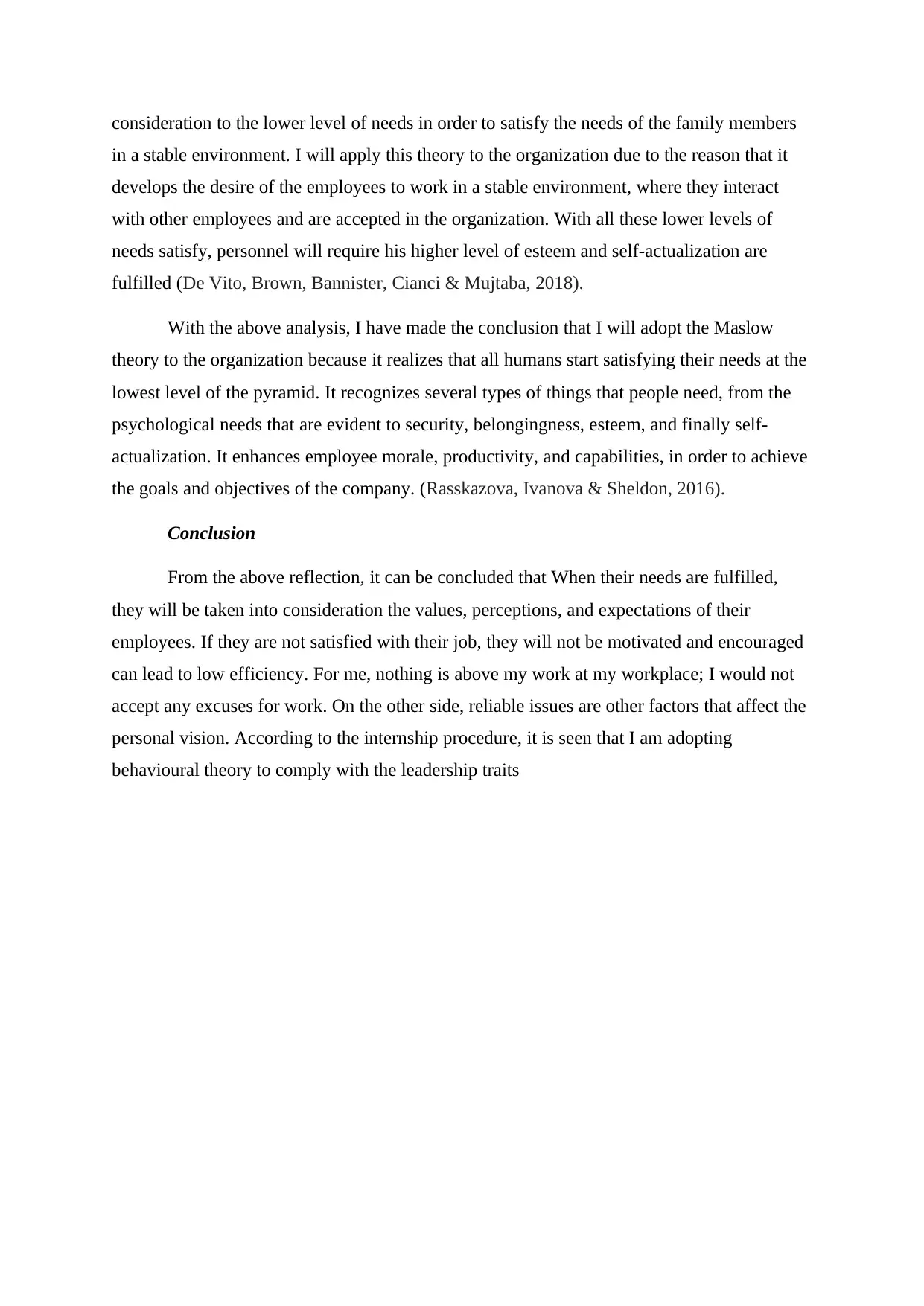
consideration to the lower level of needs in order to satisfy the needs of the family members
in a stable environment. I will apply this theory to the organization due to the reason that it
develops the desire of the employees to work in a stable environment, where they interact
with other employees and are accepted in the organization. With all these lower levels of
needs satisfy, personnel will require his higher level of esteem and self-actualization are
fulfilled (De Vito, Brown, Bannister, Cianci & Mujtaba, 2018).
With the above analysis, I have made the conclusion that I will adopt the Maslow
theory to the organization because it realizes that all humans start satisfying their needs at the
lowest level of the pyramid. It recognizes several types of things that people need, from the
psychological needs that are evident to security, belongingness, esteem, and finally self-
actualization. It enhances employee morale, productivity, and capabilities, in order to achieve
the goals and objectives of the company. (Rasskazova, Ivanova & Sheldon, 2016).
Conclusion
From the above reflection, it can be concluded that When their needs are fulfilled,
they will be taken into consideration the values, perceptions, and expectations of their
employees. If they are not satisfied with their job, they will not be motivated and encouraged
can lead to low efficiency. For me, nothing is above my work at my workplace; I would not
accept any excuses for work. On the other side, reliable issues are other factors that affect the
personal vision. According to the internship procedure, it is seen that I am adopting
behavioural theory to comply with the leadership traits
in a stable environment. I will apply this theory to the organization due to the reason that it
develops the desire of the employees to work in a stable environment, where they interact
with other employees and are accepted in the organization. With all these lower levels of
needs satisfy, personnel will require his higher level of esteem and self-actualization are
fulfilled (De Vito, Brown, Bannister, Cianci & Mujtaba, 2018).
With the above analysis, I have made the conclusion that I will adopt the Maslow
theory to the organization because it realizes that all humans start satisfying their needs at the
lowest level of the pyramid. It recognizes several types of things that people need, from the
psychological needs that are evident to security, belongingness, esteem, and finally self-
actualization. It enhances employee morale, productivity, and capabilities, in order to achieve
the goals and objectives of the company. (Rasskazova, Ivanova & Sheldon, 2016).
Conclusion
From the above reflection, it can be concluded that When their needs are fulfilled,
they will be taken into consideration the values, perceptions, and expectations of their
employees. If they are not satisfied with their job, they will not be motivated and encouraged
can lead to low efficiency. For me, nothing is above my work at my workplace; I would not
accept any excuses for work. On the other side, reliable issues are other factors that affect the
personal vision. According to the internship procedure, it is seen that I am adopting
behavioural theory to comply with the leadership traits

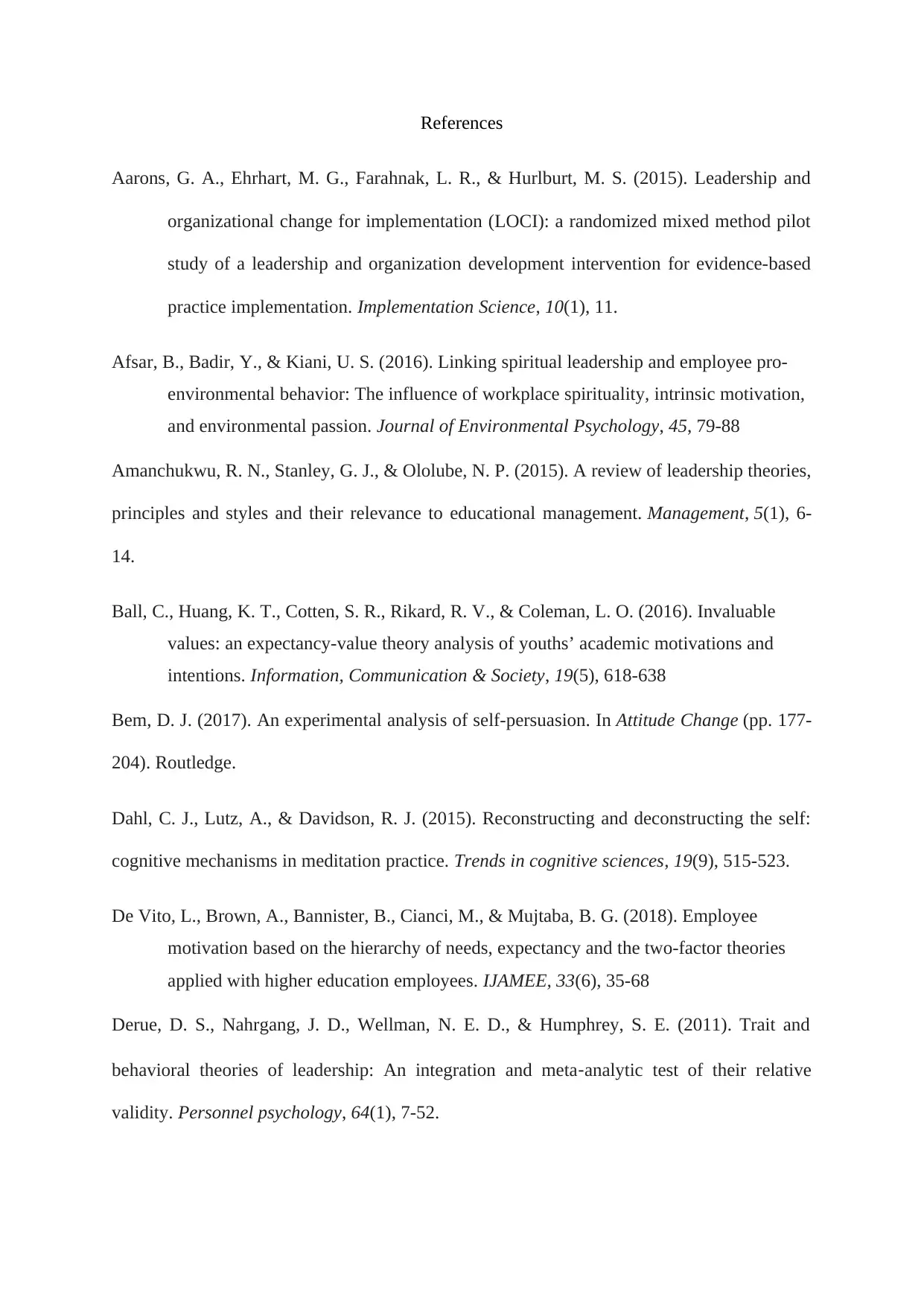
References
Aarons, G. A., Ehrhart, M. G., Farahnak, L. R., & Hurlburt, M. S. (2015). Leadership and
organizational change for implementation (LOCI): a randomized mixed method pilot
study of a leadership and organization development intervention for evidence-based
practice implementation. Implementation Science, 10(1), 11.
Afsar, B., Badir, Y., & Kiani, U. S. (2016). Linking spiritual leadership and employee pro-
environmental behavior: The influence of workplace spirituality, intrinsic motivation,
and environmental passion. Journal of Environmental Psychology, 45, 79-88
Amanchukwu, R. N., Stanley, G. J., & Ololube, N. P. (2015). A review of leadership theories,
principles and styles and their relevance to educational management. Management, 5(1), 6-
14.
Ball, C., Huang, K. T., Cotten, S. R., Rikard, R. V., & Coleman, L. O. (2016). Invaluable
values: an expectancy-value theory analysis of youths’ academic motivations and
intentions. Information, Communication & Society, 19(5), 618-638
Bem, D. J. (2017). An experimental analysis of self-persuasion. In Attitude Change (pp. 177-
204). Routledge.
Dahl, C. J., Lutz, A., & Davidson, R. J. (2015). Reconstructing and deconstructing the self:
cognitive mechanisms in meditation practice. Trends in cognitive sciences, 19(9), 515-523.
De Vito, L., Brown, A., Bannister, B., Cianci, M., & Mujtaba, B. G. (2018). Employee
motivation based on the hierarchy of needs, expectancy and the two-factor theories
applied with higher education employees. IJAMEE, 33(6), 35-68
Derue, D. S., Nahrgang, J. D., Wellman, N. E. D., & Humphrey, S. E. (2011). Trait and
behavioral theories of leadership: An integration and meta‐analytic test of their relative
validity. Personnel psychology, 64(1), 7-52.
Aarons, G. A., Ehrhart, M. G., Farahnak, L. R., & Hurlburt, M. S. (2015). Leadership and
organizational change for implementation (LOCI): a randomized mixed method pilot
study of a leadership and organization development intervention for evidence-based
practice implementation. Implementation Science, 10(1), 11.
Afsar, B., Badir, Y., & Kiani, U. S. (2016). Linking spiritual leadership and employee pro-
environmental behavior: The influence of workplace spirituality, intrinsic motivation,
and environmental passion. Journal of Environmental Psychology, 45, 79-88
Amanchukwu, R. N., Stanley, G. J., & Ololube, N. P. (2015). A review of leadership theories,
principles and styles and their relevance to educational management. Management, 5(1), 6-
14.
Ball, C., Huang, K. T., Cotten, S. R., Rikard, R. V., & Coleman, L. O. (2016). Invaluable
values: an expectancy-value theory analysis of youths’ academic motivations and
intentions. Information, Communication & Society, 19(5), 618-638
Bem, D. J. (2017). An experimental analysis of self-persuasion. In Attitude Change (pp. 177-
204). Routledge.
Dahl, C. J., Lutz, A., & Davidson, R. J. (2015). Reconstructing and deconstructing the self:
cognitive mechanisms in meditation practice. Trends in cognitive sciences, 19(9), 515-523.
De Vito, L., Brown, A., Bannister, B., Cianci, M., & Mujtaba, B. G. (2018). Employee
motivation based on the hierarchy of needs, expectancy and the two-factor theories
applied with higher education employees. IJAMEE, 33(6), 35-68
Derue, D. S., Nahrgang, J. D., Wellman, N. E. D., & Humphrey, S. E. (2011). Trait and
behavioral theories of leadership: An integration and meta‐analytic test of their relative
validity. Personnel psychology, 64(1), 7-52.
Secure Best Marks with AI Grader
Need help grading? Try our AI Grader for instant feedback on your assignments.
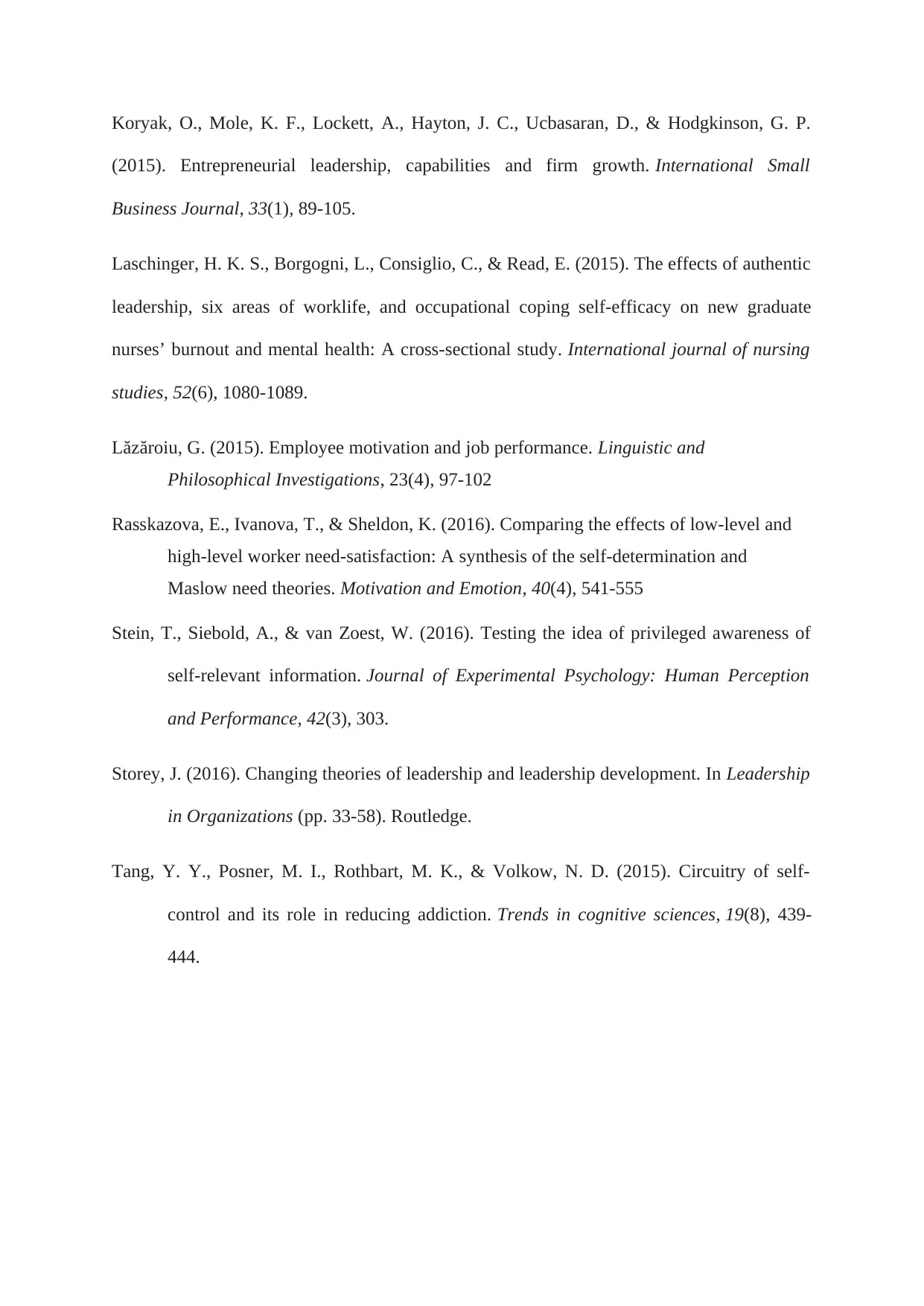
Koryak, O., Mole, K. F., Lockett, A., Hayton, J. C., Ucbasaran, D., & Hodgkinson, G. P.
(2015). Entrepreneurial leadership, capabilities and firm growth. International Small
Business Journal, 33(1), 89-105.
Laschinger, H. K. S., Borgogni, L., Consiglio, C., & Read, E. (2015). The effects of authentic
leadership, six areas of worklife, and occupational coping self-efficacy on new graduate
nurses’ burnout and mental health: A cross-sectional study. International journal of nursing
studies, 52(6), 1080-1089.
Lăzăroiu, G. (2015). Employee motivation and job performance. Linguistic and
Philosophical Investigations, 23(4), 97-102
Rasskazova, E., Ivanova, T., & Sheldon, K. (2016). Comparing the effects of low-level and
high-level worker need-satisfaction: A synthesis of the self-determination and
Maslow need theories. Motivation and Emotion, 40(4), 541-555
Stein, T., Siebold, A., & van Zoest, W. (2016). Testing the idea of privileged awareness of
self-relevant information. Journal of Experimental Psychology: Human Perception
and Performance, 42(3), 303.
Storey, J. (2016). Changing theories of leadership and leadership development. In Leadership
in Organizations (pp. 33-58). Routledge.
Tang, Y. Y., Posner, M. I., Rothbart, M. K., & Volkow, N. D. (2015). Circuitry of self-
control and its role in reducing addiction. Trends in cognitive sciences, 19(8), 439-
444.
(2015). Entrepreneurial leadership, capabilities and firm growth. International Small
Business Journal, 33(1), 89-105.
Laschinger, H. K. S., Borgogni, L., Consiglio, C., & Read, E. (2015). The effects of authentic
leadership, six areas of worklife, and occupational coping self-efficacy on new graduate
nurses’ burnout and mental health: A cross-sectional study. International journal of nursing
studies, 52(6), 1080-1089.
Lăzăroiu, G. (2015). Employee motivation and job performance. Linguistic and
Philosophical Investigations, 23(4), 97-102
Rasskazova, E., Ivanova, T., & Sheldon, K. (2016). Comparing the effects of low-level and
high-level worker need-satisfaction: A synthesis of the self-determination and
Maslow need theories. Motivation and Emotion, 40(4), 541-555
Stein, T., Siebold, A., & van Zoest, W. (2016). Testing the idea of privileged awareness of
self-relevant information. Journal of Experimental Psychology: Human Perception
and Performance, 42(3), 303.
Storey, J. (2016). Changing theories of leadership and leadership development. In Leadership
in Organizations (pp. 33-58). Routledge.
Tang, Y. Y., Posner, M. I., Rothbart, M. K., & Volkow, N. D. (2015). Circuitry of self-
control and its role in reducing addiction. Trends in cognitive sciences, 19(8), 439-
444.
1 out of 11
Related Documents
Your All-in-One AI-Powered Toolkit for Academic Success.
+13062052269
info@desklib.com
Available 24*7 on WhatsApp / Email
![[object Object]](/_next/static/media/star-bottom.7253800d.svg)
Unlock your academic potential
© 2024 | Zucol Services PVT LTD | All rights reserved.




